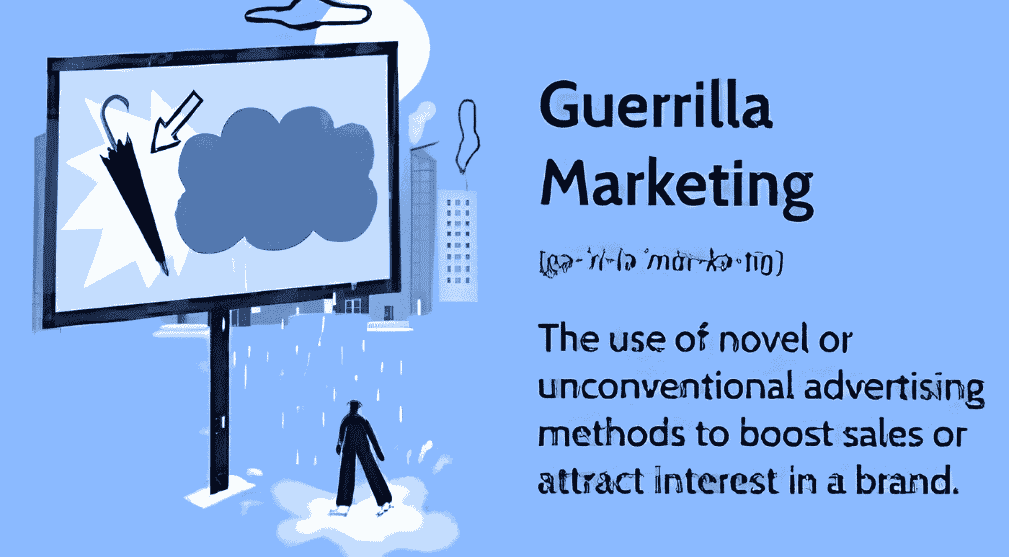
1. What is Guerrilla Marketing?
Guerrilla marketing is an unconventional advertising strategy that relies on surprise, creativity, and low-cost tactics to promote products or services with maximum impact and memorability 1. The term was introduced by Jay Conrad Levinson in his 1984 book “Guerrilla Advertising,” drawing inspiration from guerrilla warfare tactics that employ resourcefulness and unexpected approaches 23. This marketing approach focuses on creating unique, eye-catching experiences that generate significant brand awareness despite limited financial resources.
Unlike traditional advertising methods, guerrilla marketing prioritizes imagination, energy, and time investment rather than substantial monetary expenditure 4. The strategy specifically targets consumers in unexpected locations through interactive, unconventional campaigns designed to provoke thought and create lasting impressions 3. These encounters often occur in public spaces, using creative disruptions to delight and surprise the audience 5.
The fundamental principles of guerrilla marketing include strategic location selection, perfect timing, and cultural context alignment. These elements combine to frame consumer encounters in ways that maximize impact and relevance 3. Furthermore, successful guerrilla marketing maintains authentic alignment with the brand’s core identity and values, ensuring that unconventional tactics reinforce rather than contradict established brand positioning.
Particularly beneficial for small businesses and entrepreneurs with constrained budgets, guerrilla marketing enables them to compete effectively against larger companies 54. Rather than investing in expensive television, newspaper, or radio advertisements, guerrilla marketers focus on creativity and strategic implementation 6. Currently, approximately 90 percent of Americans use the internet, averaging over six hours online daily, making digital platforms increasingly important channels for guerrilla marketing campaigns 5.
The primary objectives of guerrilla marketing include increasing brand awareness, creating viral potential, fostering engagement, ensuring cost-effectiveness, disrupting markets, and establishing emotional connections with audiences. These campaigns are designed to be shareable, often spreading through word-of-mouth and social media, exponentially increasing reach at minimal cost 1.
2. Why Guerrilla Marketing Works for Small Budgets
Small businesses with limited marketing resources stand to benefit significantly from guerrilla marketing strategies. This approach levels the playing field, allowing smaller enterprises to compete effectively with larger corporations through creativity and ingenuity rather than substantial financial investments 2. The cost-effectiveness of guerrilla marketing represents one of its most compelling advantages for businesses operating with constrained budgets.
Traditional advertising methods such as television commercials, print advertisements, and billboards often require substantial capital. According to research by Nielsen, guerrilla marketing campaigns have a median cost of only PKR 27,768.17, compared to the median cost of PKR 138,840,859.49 for traditional advertising campaigns 7. This dramatic cost difference makes guerrilla marketing particularly attractive for small businesses seeking maximum impact with minimal expenditure.
The financial efficiency of guerrilla marketing stems from its emphasis on creative thinking over monetary investment. As Jay Conrad Levinson, the originator of the term, stated: “The soul and essence of guerrilla marketing [is] achieving conventional goals, such as profits and joy, with unconventional methods, such as investing energy instead of money” 5. This philosophy encourages businesses to leverage resourcefulness and innovative thinking instead of relying solely on financial backing 8.
Additionally, guerrilla marketing offers several key advantages that make it ideal for small budget operations:
- Organic Reach: Creative campaigns have significant potential to generate buzz and go viral, attracting spontaneous attention without additional advertising costs 7.
- High Memorability: Unconventional tactics create lasting impressions, increasing brand recall among consumers 7.
- Targeted Exposure: Campaigns can be tailored to specific audiences and locations, maximizing relevance and impact 6.
- Competitive Edge: Innovative approaches help brands stand out from competitors using conventional marketing 6.
For local businesses, guerrilla marketing offers practical opportunities to connect with community members through creative street propaganda, pop-up installations, or participation in local events 5. These tactics generate authentic engagement while maintaining strict budget discipline.
3. Types of Guerrilla Marketing
Guerrilla marketing encompasses several distinct approaches, each with unique characteristics and applications. These variations share the fundamental principle of unconventional marketing but differ in execution, location, and audience engagement techniques.
Ambient Marketing
Ambient marketing places advertisements in unusual locations to surprise consumers and create memorable impressions. Unlike traditional advertising, ambient ads appear where people least expect them, utilizing the element of surprise to affect viewers emotionally 10. This technique transforms ordinary environments into creative advertising spaces, often through stickers, large displays, or interactive elements in public places. The unconventional placement helps brands stand out in media-saturated environments where conventional advertising is frequently overlooked 10. Ambient marketing offers significant cost advantages over traditional campaigns while simultaneously generating stronger emotional connections with audiences 11. The effectiveness of ambient ads stems from their ability to hold attention significantly longer—studies show billboard advertisers typically capture a vehicle passenger’s attention for approximately six seconds, whereas creative ambient advertising can extend this to a minute or more 11.
Experiential Marketing
Experiential marketing creates immersive, interactive experiences that enable customers to engage directly with brands. This approach transforms passive consumers into active participants through memorable interactions 12. Rather than simply showcasing products, experiential marketing builds emotional connections by allowing audiences to interact with the brand through events, installations, or activities 12. The strategy leverages real-time feedback opportunities, personalization, and storytelling to create lasting impressions. Experiential marketing proves effective because it creates deeper engagement than conventional advertising—approximately 9 out of 10 consumers prefer experiencing products firsthand 13. Through this approach, brands can demonstrate their values and personality while collecting valuable customer insights during interactions.
Viral Marketing
Viral marketing aims to inspire individuals to share marketing messages with their networks, creating exponential growth in reach 1. The goal is spreading information organically through word-of-mouth or internet sharing, particularly via social media platforms 1. Successful viral campaigns typically have three essential components: compelling message, effective messengers, and conducive environment 1. Though difficult to predict, viral success can generate massive exposure with minimal investment—the ALS Ice Bucket Challenge, for instance, raised PKR 61089.98 million through viral sharing 1. However, viral marketing presents challenges, including measurement difficulties and potential negative reactions that can spread rapidly 1.
Street Marketing
Street marketing encompasses grassroots promotional activities conducted outside business premises in public spaces 14. Tactics include distributing flyers, posting menus through letterboxes, hanging posters, and creating interactive displays in high-traffic areas 14. Effective street marketing allows brands to personally introduce themselves to potential customers, build trust through repeated exposure, and demonstrate products directly 14. The approach works best when marketers focus on specific areas and customer groups, perfect their pitch, and maintain professional appearance through branded materials 14. Street marketing essentially “breaks the fourth wall” of advertising by drawing potential customers into unique experiences 4.
Event Ambush Marketing
Event ambush marketing strategically associates brands with events without official sponsorship 3. This controversial approach typically targets major sporting events with large audiences to gain visibility without paying substantial sponsorship fees 3. Ambush marketing employs various tactics, including indirect association (avoiding reference to protected intellectual property), ambush by distraction (overshadowing official sponsors), and self-promotion (aggressively promoting support without authorization) 3. Though potentially effective, ambush marketing carries significant legal risks—as demonstrated by Bavaria Beer’s 2010 FIFA World Cup campaign, which resulted in arrests and controversy 3. Nevertheless, when executed properly, ambush campaigns can achieve remarkable brand recognition at minimal cost, as exemplified by Nike’s “Find Your Greatness” campaign during the 2012 London Olympics, which outperformed official sponsor Adidas in global brand recall (21% vs 17%) 3.
4. How to Plan a Guerrilla Marketing Campaign
Planning a guerrilla marketing campaign requires systematic preparation despite its seemingly spontaneous execution. Effective campaigns balance creativity with strategic methodology to maximize impact on minimal budgets.
1. Define your goal and audience
Initially, establish clear objectives for your campaign using SMART criteria (specific, measurable, achievable, relevant, time-bound) 15. Whether aiming to increase brand awareness, drive website traffic, or boost sales, specific goals provide direction throughout the campaign development process 16. Concurrently, conduct thorough audience research to understand preferences, behaviors, and pain points 9. Identifying demographic characteristics, online habits, and engagement triggers ensures your campaign resonates with intended recipients 9. Focus on people genuinely interested in your products rather than targeting random crowds 17.
2. Choose a creative concept
The creative concept must grab attention through three essential pillars: a strong hook, focus on an idea rather than a product, and something tangible 18. During ideation, aim to generate numerous concepts rapidly—perhaps 100 ideas in an hour 7. Create mood boards to inspire team members and collaborate with diverse departments for unique perspectives 7. Ultimately, evaluate whether your concept will make people stop and think, “Oh, that’s surprising” 18. Originality remains paramount; if your concept resembles another brand’s campaign, reconsider your approach 7.
3. Pick the right location and timing
Location selection significantly impacts campaign visibility and effectiveness 16. Strategic placement in high-traffic areas frequented by your target audience maximizes exposure 8. Consider unconventional spaces like stairs, benches, street corners, and even public restrooms 8. Alongside location, timing must align with current events, upcoming holidays, or trending topics to enhance relevance 9.
4. Prepare materials and team
Prior to launch, ensure all materials are prepared and the team thoroughly briefed 19. Consider potential challenges including city laws, weather conditions, theft, and audience reactions 17. Develop contingency plans for unexpected obstacles 20. Verify that all elements align with your brand identity so customers can find connections between your offline tactics and overall business objectives 17.
5. Launch and monitor reactions
Throughout the campaign, track performance using appropriate metrics based on your initial objectives 15. Monitor engagement, conversion rates, website traffic, social media mentions, and sales figures 19. Incorporate clear calls-to-action like “Buy Now,” “Sign Up,” or “Win” to measure effectiveness 18. This data enables real-time adjustments and informs future campaign development 21.
5. Best Practices for Guerrilla Marketing
Effective execution of guerrilla marketing campaigns hinges upon following established best practices that maximize impact while minimizing potential risks. Initially, understanding your target audience thoroughly enables creation of campaigns that genuinely resonate with consumers 28. Correspondingly, setting SMART objectives (specific, measurable, achievable, relevant, time-bound) provides clear direction for campaign development 21.
Creativity remains fundamental to guerrilla marketing success, as originality and innovation differentiate campaigns in crowded marketplaces 21. Indeed, strategic location selection significantly impacts visibility and effectiveness—choose high-traffic areas frequented by your target demographic 19.
Legal due diligence represents an essential consideration—research permit requirements and maintain contact with local authorities where necessary 29. Likewise, avoid potentially offensive content by remaining mindful of cultural sensitivities and current events 6.
For measurement purposes, track key performance indicators including:
- Response and conversion rates
- Customer acquisition costs
- Growth metrics
- Retention rates
- Social media engagement
Integration with broader marketing strategies enhances effectiveness, as guerrilla marketing should complement traditional advertising methods rather than replace them entirely 5. Studies indicate guerrilla marketing can significantly boost brand awareness, increasing purchase likelihood 5.
6. Conclution
Guerrilla Marketing in 2025 proves that creativity will always outweigh a massive budget. For small businesses, it opens the door to compete with bigger brands by thinking outside the box and connecting with audiences in unexpected ways. Whether it’s through street art, viral memes, experiential campaigns, or social media stunts, the true power of guerrilla marketing lies in its ability to surprise, entertain, and stay memorable.
As digital platforms evolve, blending online and offline tactics will make campaigns even more impactful. By planning carefully, understanding the audience, and embracing bold ideas, small businesses can turn low-cost campaigns into high-impact success stories. In the end, guerrilla marketing is not just about saving money—it’s about building stronger emotional connections, driving brand awareness, and creating moments that people will remember long after the campaign ends.
It’s a low-cost, creative marketing strategy that relies on surprise, innovation, and high impact—perfect for small businesses with limited budgets.
In 2025, guerrilla marketing blends offline creativity with digital tools like AR, viral social media campaigns, and influencer collaborations for maximum reach.
If poorly executed, it can confuse audiences, appear unprofessional, or even cause legal/ethical issues. Planning and audience research are key.
Yes, it can start locally with physical stunts, street art, or community engagement. Social media simply amplifies its impact.
Define your target audience, set a clear goal, and brainstorm a bold yet cost-effective idea that sparks attention and fits your brand values.

